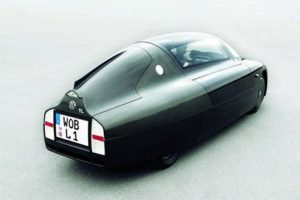“Science is not about making predictions or performing experiments. Science is about explaining.” Bill Gaede
The first ‘Hypercars’ were built during the 1990s. GM and VW followed Amory Lovins’ guidance and undertook to make a car to his principles. The EV 1 was a bold experiment whose time had not yet arrived – lacking the Lithium-Ion battery technology.
For Volkswagen, what better way to explain the science behind it than to prove it? Having the small IC engine experience, they named their experiment the ‘One Liter’ car; I call it a ‘Hypercar’ proto-type. Apropos ‘Hypercar’, today’s so-called supercars have taken on the term hypercar mistakenly when they produce more than 1000 HP or accelerate to 100 km/h (62 mph) in under 3 seconds. Hypercar® is a registered trademark of the Rocky Mountain Institute.
The ‘One Liter’ prototype’s engine does not have a capacity of 1 Liter, instead, it refers to fuel consumption of 1 liter per 100 kilometers. (1l/100km equals 235 mpg US; 282 mpg Imperial; 62 miles with 1 liter of fuel)
Volkswagen built the world’s most economical car in 1992. It was driven 230 km from Volkswagen’s plant in Wolfsburg to the annual general shareholders meeting in Hamburg. Ferdinand Piech, Chairman at the time, drove this research vehicle at 75km/h average, including city & Autobahn. On that historic trip, the car consumed only 0.89 l/100km. (264 mpg US / 317 mpg Imp.) Beating their own prediction. Impressive!
Lovins vision of a Hypercar® includes improved aerodynamics, light-weight construction, and zero emission (electric) drive. During the 1990s, electric drivetrains were not sufficiently developed to drive any great distance. A small diesel engine had to meet the requirements of proving VW’s experiment to the world.
Lovins’ work (see the previous article) “focuses on transforming the hydrocarbon automobile, and several other sectors. He has briefed and explained his ideas to eighteen heads of state, held several visiting academic chairs, authored or co-authored twenty-nine books and hundreds of papers. The Wall Street Journal named him one of thirty-nine people worldwide “most likely to change the course of business; Newsweek has praised him as “one of the world’s most influential energy thinkers”; and Car magazine ranked him among the most powerful persons in the global automotive industry.
On the long path to fuel cell electric vehicles (FCEV) driving on every street, many small steps are being taken. It took a generation from Karl Benz’s auto buggy to the Model T, and it will be several more years until every automaker has changed over to “Live better electrically”. When General Electric used that slogan during 1950’s, nobody envisioned that a musical group so named would be “Best Live Band” three years running more than fifty years later. From loud music to silent motoring, electric is eclectic.
Lovins calculates that North America could run without oil by 2050. Long before then, fuel-efficient cars, alternative fuels, battery-electric, hydrogen, and fuel cell powered vehicles will become increasingly important for transporting people and goods on highways and byways around the world.
“We’re in that period where one idea is dying and another is struggling to be born,” says Amory Lovins. He continues, “A Hypercar vehicle is designed to capture the synergies of ultra-light construction; low-drag design; electric drive; and equal or better performance, safety, amenity, and affordability, compared to today’s vehicles.”
“Whole-system design means optimizing not just parts, but the entire system — in this case, the complete car, although for an extra challenge one could try to optimize the automotive industry at the same time as the Hypercar®.”
“Investing in our students today will ensure the transformation of our energy future from one dependent on petroleum to one that utilizes the most abundant element in the universe — hydrogen.”
“Any Hypercar’s body is molded from advanced composites of carbon fiber; its light mass supersedes the need for a heavy engine and can be efficiently propelled by an electric motor combined with fuel cells. In terms of safety, the materials and design of the Hypercar® can withstand crashes much like the Indianapolis racecars, also made of carbon fiber: in the case of a collision, the car’s shell shatters [crumple zone] to absorb the force of the impact. By combining all these features in a whole-system approach, these revolutionary vehicles are multiple times more efficient than comparable current models.”
To summarize: “Hypercar® is not a new model of a ‘supercar’, but an idea, a vision of a vehicle that comes in many different sizes, shapes, and materials; a vehicle that can be powered by different energy sources and which can be built anywhere by anyone with a minimum of instruction.
“The Hypercar® is viewed as the automotive declaration of independence; independence from oil, freedom from greenhouse gas and other emissions, liberty to use modern materials and power-plants and the autonomy to produce suitable vehicles for sustainable transportation at markets everywhere.
“The gains in any vehicle designed to Hypercar® principles are based on a blend of four considerations: 1/ low-drag design 2/ lightweight construction 3/ electric drive 4/ efficient accessories.
From the ‘One Liter’ prototype of 1992 to the limited production Volkswagen LX1 in 2012, automotive evolution around the world has made great strides.
I am getting ahead of the time again here, quoting Amory Lovins, “The commercialization of the Hypercar® began in 2014, with the production of the all-carbon electric BMW i3 family and the 313 miles per gallon Volkswagen XL1.”



